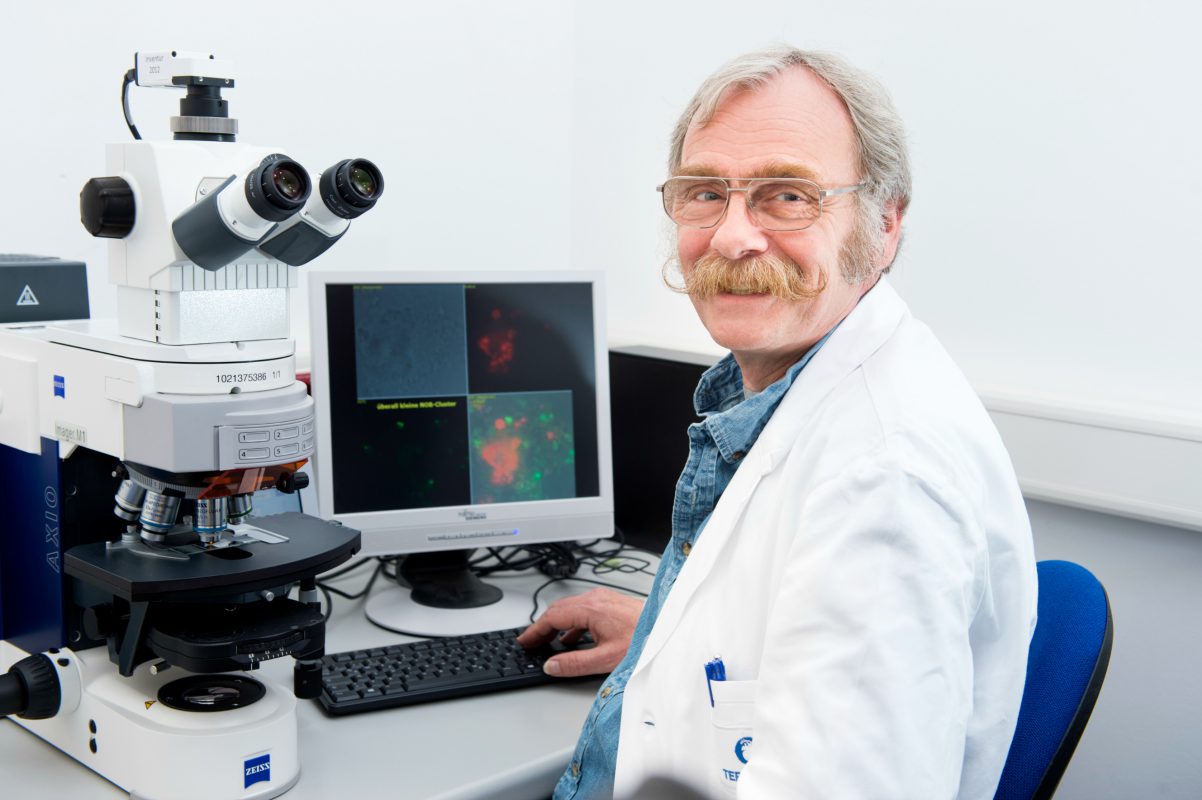Bacteria belong to an entirely separate domain of life to animals and plants. They cannot form multicellular organisms like humans, trees or fish and their cells are much smaller than the cells that make animals or plants, making their world completely invisible to us. Their cells lack the structures that can clearly be seen under a basic microscope in the cells of animals or plants, most notably, their cells lack a nucleus.
Despite their simple life form, bacteria are crucial to all life on Earth; the total biomass of bacteria on the planet outweighs the biomass of all other life by ten times yet look out of the window and we cannot even see one!
Bacteria recycle nutrients by feeding on decaying matter, give us essential products such as yoghurt and cheese and in more modern times have been manipulated in laboratories to produce vital molecules such as insulin. At a more sinister level, bacteria are responsible for some of the most debilitating human and animal diseases, and fish are no exception.
So, bacteria are a vital component of our aquarium and ponds, the friendly ones perform essential functions and without them, fishkeeping would not be possible. However, some bacteria can take advantage of weakened or wounded fish and others are nothing but dirty rotten parasites!
Bacteria in your aquarium and ponds
The water in an aquarium or pond is absolutely teeming with all sorts of microscopic life. Take a drop of water out of your filtration system and examine it under the microscope and you will marvel at the site of thousands of tiny organisms all happily feeding on waste material as well as each other! These, however, are the giants of the microscopic world, bacteria can only be seen by the strongest light microscopes and even then, we can just see faint outlines.
The beneficial bacteria in an aquarium or pond perform a vital function of breaking down the toxic waste released by your fish and other living organisms. These beneficial bacteria can be split into two groups; the nitrifiers and the heterotrophs, and both should be looked after just as much as your fish.
Heterotrophic bacteria feed on organic compounds. By organic, I mean in a chemical sense, not in the sense that we’re used to in our day-to-day lives. Organic compounds are those that contain carbon-hydrogen bonds and make up the chemical basis of life. This includes fish waste matter, decaying plants, sloughed-off fish mucous and skin cells and rotting uneaten fish food.
Nitrifiers perform a much more useful function of breaking down the toxic waste ammonia released from the fish and other living organisms including the heterotrophs. Most fishkeepers are aware of the existence and importance of these bacteria because they break down toxic nitrogen-containing waste. Breakthrough in technology over recent years has found that Nitrospira and Nitrosospira are the main species in the nitrification process, both of which are contained within Tetra Safestart and FIlterActive.
How can levels of heterotrophic bacteria be kept down?
Two of the more popular bacteria living in your pond are heterotrophic and autotroph bacteria. Levels of heterotrophic microbes can be kept to acceptable levels simply by ensuring your filtration system remains clean. A clean aquarium or pond has less organic material in for these bacteria to feed on but be sure to take special care of the foams inside your filter. In small filters, the foams must not be cleaned in tap water as they trap solid wastes and provide a home for the nitrifiers. In larger filters, solid waste is held in a separate area, so the foams can be cleaned with tap water and patted dry before placing back in the filter.
By using products such as a Tetra’s Gravel Cleaner to regularly ‘hoover’ the aquarium gravel at each water change or using a good pond ‘vacuum cleaner’ to clean the pond bottom, together with efficient mechanical filtration which is regularly cleaned, and preventing an accumulation of leaves in the pond, the build-up of organic material will be reduced. With less heterotrophic bacteria around, there is more space in the biofilter for the autotrophs (or nitrifiers) and there will be less ammonia released. (Remember the sludge you have just removed when cleaning would otherwise decay and ultimately release ammonia).
It’s not just bacteria that needs a helping hand
So far, we have been using the term ‘bacteria’ to include a variety of useful organisms that breakdown troublesome waste in the aquarium and pond. Recent research indicates there is another group of organisms that also play a vital role. Known as the ‘archae’, these are an ancient group of bacterial-like organisms. Whilst the resemblance to bacteria is strong, it’s at the molecular level that vital differences become apparent. Studies on the nitrifying community indicate the ammonia-oxidising community was in some cases made up exclusively of various archae species.
Nitrifying bacteria and archae are totally dependent on dissolved oxygen in the water, we can see this when we examine the chemical formulae for ammonia, (NH4+), nitrite, (NO2–) and nitrate, (NO3–); notice the addition of oxygen atoms to the nitrogen. Similarly, high concentrations of substrate, (i.e. ammonia or nitrite) can have an inhibitory effect on growth of some strains whereas others can be inhibited when there is too little substrate present. Different strains of nitrifying bacteria will be adapted to specific substrate concentrations, as well as different habitats in the more traditional sense of freshwater or marine, cold water or tropical. The nitrifying community in your local sewage works will be very different to those found in a freshwater aquarium or an intensive recirculating marine fish farm. Some key research around 15 years ago focused on this very concept, asking what are the bacterial strains typically associated with freshwater and marine aquaria? The answer to this question then directly led to the development of Tetra’s SafeStart and FilterActive.
Just as with fishkeeping, the actual values of temperature DO, pH, KH, ammonia or nitrite often matters less than their stability. Wildly fluctuating pH or DO levels will harm these nitrifiers as much as your fishes! Which is why large water changes might be a source of fluctuations – a series of smaller water changes is preferable.
Modern research tools allow us to investigate all of the microbes that thrive in our aquarium and pond. Through the ongoing discovery of bacteria species to the recent discovery of the importance of archae, it seems we have a lot more to find out!

